What is an inverter air conditioner and how does it differ from an ordinary one?
To create a comfortable indoor microclimate, various devices are used to regulate air parameters.A modern inverter air conditioner or split system is designed to provide the required temperature and humidity in the room.
Understanding the operating principles, internal structure and technical nuances will allow you to make the right choice when purchasing an air conditioning system. Let's look into these subtleties together.
The content of the article:
Comparison of inverter and conventional devices
When choosing between classical and inverter type systems, it is necessary to rely on a clear idea of the desired result, an understanding of the operating principles of such air conditioners and the technical feasibility of their use.
The principle of operation of different air conditioning systems
Let's consider the principle of operation of an ordinary air conditioner in the mode of maintaining a given air temperature in a certain range.
So, when working for cooling, the device operates until the minimum temperature range is reached, after which it turns off. As soon as the temperature sensor detects that the temperature has reached the upper limit of the range, the air conditioner turns on.
The temperature range for all classic-type devices is from three to five degrees, otherwise frequent switching on and off will quickly damage it. Simpler and cheaper systems are turned on manually or by timer.
When the required temperature is reached, the inverter system begins to operate in its support mode.This is expressed in a decrease in the number of compressor engine speeds that pump freon to the evaporator, which leads to a decrease in temperature transfer. Read about how coolant is refilled into the air conditioning system. this material.
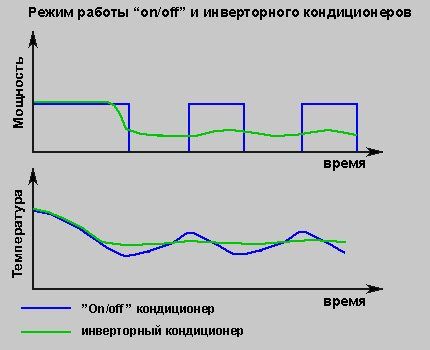
Thus, the principle of operation of ordinary air conditioners is alternating operation with constant power. And inverter devices operate in constant mode with variable power.
For the consumer this is expressed as follows:
- the flow of cold air when cooling or warm air when heating is more powerful in conventional systems during their operation, which can cause discomfort;
- inverter systems maintain the set temperature more evenly;
- Conventional systems make more noise, especially when turning on and off.
Therefore, from the standpoint of creating a suitable indoor microclimate, the new type of air conditioners clearly outperforms their classic predecessors.
Pros and cons of the technical plan
Like any innovation, inverter systems have positive and negative technical aspects compared to models made using previous technology.
One of the main criteria by which the user chooses equipment is the cost of both the device itself and its maintenance and repair. As a rule, recently launched products have a price significantly higher than that of outdated models. A similar situation has developed in the air conditioner market.
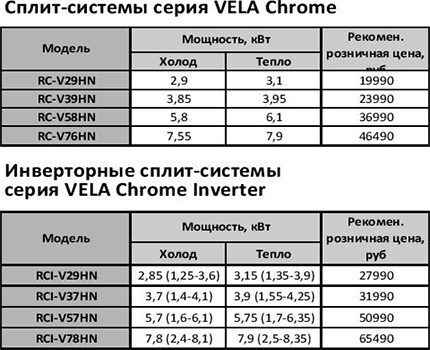
In addition, the cost of service, repair or replacement of spare parts for inverter systems is significantly higher. The price of the frequency converter electronic board costs almost the same as the other components of the device.
There are practically no third-party parts on the market, while for older models there is a large selection of compatible components.
The second problem is that both monoblock devices and split systems of the new inverter type are complex electronic devices. Therefore, despite the presence of integrated safety components, it is necessary to ensure a high-quality power supply to avoid damage.
The third problem is the risk of failure of expensive electronics. Even with normal power supply, aging and loss of volume in capacitors, thermal breakdown of power elements and other problems typical of boards can occur over time.
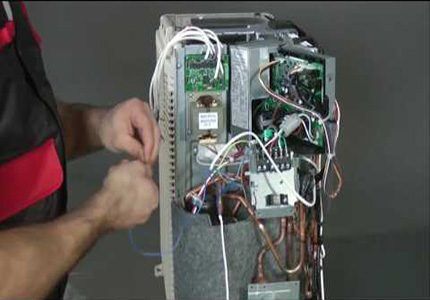
In terms of energy savings, there is no clear answer. As manufacturers say, during normal operation, inverter systems are more economical than classic ones, which at startup consume a lot of resources with low efficiency. This is true, but the savings are not so great that we can talk about quickly compensating for the price difference.
If we compare the operation of models at a constant maximum power, then with the same technical indicators, the new models are inferior to the classic ones due to the fact that thermal energy is released during double current conversion. Therefore, this mode of using inverter systems is impractical.
But from the point of view of the device’s impact on the electrical network, inverter devices are definitely better. They consume electricity evenly, so the maximum load is less than with a classic type air conditioner.
In addition, every time at the start, a peak load occurs and a voltage drop occurs. If the cross-section of the power cables is insufficient, this is especially noticeable and negatively affects the quality and safety of the operation of other devices in the circuit.
Over time, the shortcomings of the new technology will be eliminated or will have to be accepted due to the significant improvement in comfort compared to the use of previous generation devices.
We also recommend reading the article about the most common malfunctions of split systems and ways to eliminate them.
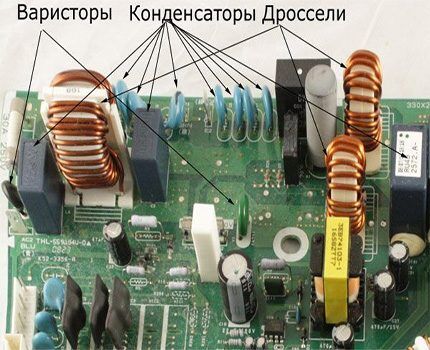
Split system device
Externally, air conditioners of both types of action do not differ from each other. The technical difference is that the switching relay in the inverter version is replaced by a frequency converter, which is a power electronics unit.
It includes:
- rectifier, converting standard alternating current into direct current;
- inverter, converting direct current into alternating current of the required frequency.
The operation of the inverter is regulated by a special controller integrated into the electronic system control unit. It determines the frequency of the current supplied to the generator, thus controlling the rotation speed of the compressor motor.
A split cooling system consists of two blocks, one of which is located indoors and the other outdoors.
The outdoor unit of inverter-type devices includes the following main elements:
- capacitor (usually in the form of a radiator with a fan), in which cooling and phase transition of freon occurs;
- compressor, which compresses freon or other refrigerant and ensures movement along the circuit;
- freon system filter, protecting the compressor from dirt;
- four way valve, which reverses the freon flow when changing the cooling mode to heating and back;
- a frequency converter;
- control board external block.
For conventional air conditioners, all electronics are usually located in the indoor unit and are less susceptible to dust and temperature changes. The reason for moving the power electronics board outside is heat generation from the inverter.
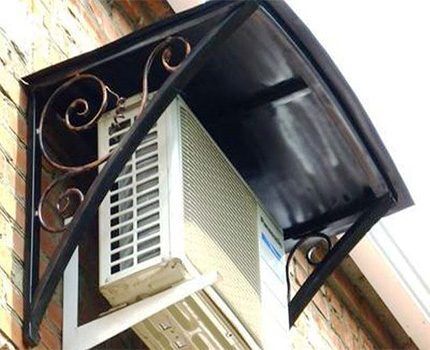
The indoor unit includes the following devices:
- evaporator (radiator with fan), in which the refrigerant is heated by cooling the incoming air;
- coarse filter, designed to capture large suspended matter, such as dust, animal hair or fluff;
- fine filter system (carbon, antibacterial, electrostatic, etc.);
- control board indoor unit;
- Front Panelthrough which air enters the unit;
- horizontal and vertical blinds, designed to adjust the direction of the outgoing flow;
- indicator panel.
Copper tubes connecting the indoor and outdoor units are connected using a special fitting connection.
Scope of application of typical cooling systems
For new models, it is best to use the reduced power mode for as long as possible, because this allows you to ensure that the inverter air conditioner operates in such a way that its best qualities will be used. And when operating at maximum power, inverter devices are no better than their outdated counterparts, but are more expensive both in price and in maintenance.
In the reduced power mode in the room, the air conditioner compensates for the temperature change that occurs due to heat exchange between the air and the walls, floor, ceiling, as well as as a result of a slight influx of air from the outside.
If the replacement of the air mass occurs frequently and the temperature difference between inside and outside is significant, then the economical mode is ineffective.
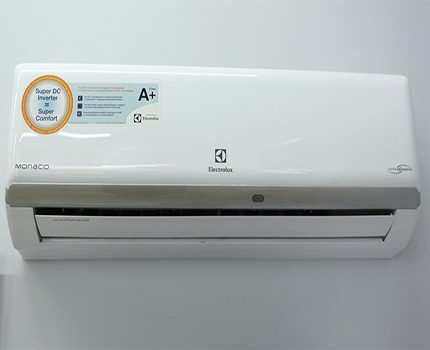
Thus, inverter systems are used mainly for living rooms and offices, where it is necessary to create a favorable microclimate and there is no significant air flow.
There is no need to use inverter systems for the following objects:
- residential premises where air conditioning is rarely used, such as a summer house;
- kitchens and other technical objects in which temperature changes often occur due to the operation of devices located there.
It is better to equip with a classic version of the cooling system those rooms where frequent air replacement occurs: offices, shops, halls and other public places where you can observe a large flow of people through the entrance doors, warehouses, hangars and other objects with a large entrance gate area.
Technical rooms where there is a uniform release of heat due to the equipment located there (for example, a server room) are best equipped with several inverter cooling systems. It is impossible to use ordinary air conditioners at such facilities, since they cannot operate around the clock.
Purchase nuances and popular manufacturers
When choosing an inverter cooling system, you need to make sure that it is capable of providing the required room microclimate while operating in reduced power mode.
To do this, you need to know the parameters of the room, such as floor area and ceiling height. There are more complex calculations for air conditioners from different manufacturers, but as a rule, the result is not very different from a simple model.
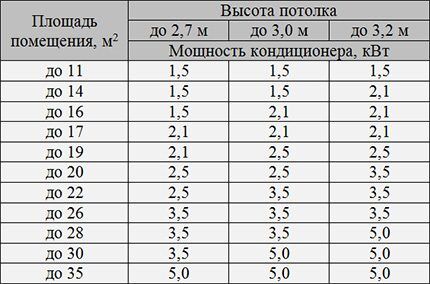
The lack of compatible components for the electronic boards of inverter split systems leads to problems when they break down. Service centers do not repair electronics. In case of board replacement, in addition to the high price, the problem is the waiting time for spare parts.
Sometimes the reason why the board has failed is elementary from the point of view of its elimination. Replacing 3-5 swollen capacitors will cost 700 - 1,000 rubles, while the cost of the entire unit is about 10,000, and the time spent on repairs will take 1-2 hours.
This service can be provided by almost any computer and mobile phone repair company. However, this requires documentation for the electronic board, and all parts must be marked on the device itself. This must be checked before purchasing an air conditioner.
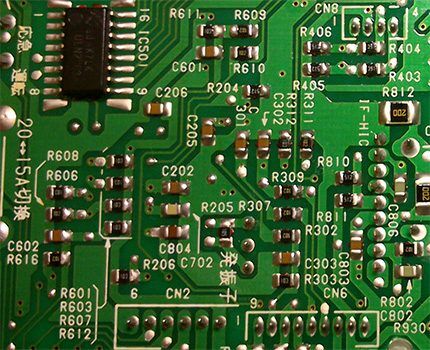
Due to the high cost and technological innovations, when purchasing an inverter-type cooling system, it is better to opt for models from well-known manufacturers.
Devices from the following companies are popular:
- Japanese Mitsubishi Electric And Daikin they produce very high-quality products that are somewhat more expensive than analogues from other manufacturers;
- Japanese Mitsubishi Heavy, Panasonic, Fuji, Fujitsu, Hitachi And Toshiba, as well as South Korean LG, Samsung And Hyundai also in good standing with consumers;
- Turkish Koc Holding produces air conditioners and other equipment under the brand name "Beko", which is assembled in China;
- Swedish corporation Electrolux is the flagship among European companies producing household appliances, although their air conditioners are also assembled in China;
- Chinese Ballu, Haier And Midea produces fairly high-quality products, and at a very affordable price.
Russian-assembled air conditioner models can be classified as budget options. They do not have any significant differences from foreign analogues in terms of price/quality ratio.
The following photo gallery will introduce you to the TOP 8 inverted air conditioners, which according to users are the most effective, and according to sellers, are sold out with a bang:
Our website also has an article in which the models are analyzed in detail and a rating of the best split systems according to users is presented, we recommend that you read it. More details - go to link.
Conclusions and useful video on the topic
Comparison of conventional and inverter systems, advice on the need for the proposed options:
Purchasing inverter systems will help create a suitable microclimate and ensure a comfortable stay at home or in the office.
In order for the air conditioner to function properly and for a long time, it is necessary to take a responsible approach to choosing the manufacturer, the required power and provide the technical conditions for the operation of the system.
Do you have a question about inverter air conditioning systems? Please leave your comments in the block below the article. Here you can report an interesting fact on the topic of the article or supplement the material with your own observations.




With the onset of summer, many families are thinking about purchasing air conditioning systems. We were no exception and chose an inverter-type split system. Firstly, the equipment operates in an economical mode: when you need to cool the air by only 1 degree, the inverter air conditioner will not operate at full capacity. In fact, it makes it possible to reduce energy costs, it is quieter, and there are no surges in the network during startup. The wiring in the house is old, powerful current consumers are a problem.
When we were choosing an air conditioner for our apartment, we decided to take only the inverter type. Firstly, it still saves energy: the engine runs at low speeds and maintains a constant temperature. If it starts to rise, it will start working again. Secondly, there is no surge in electricity consumption. Thirdly, it is quieter because the compressor rattles less. Of course, it will be more expensive, but the issue of price did not bother me.